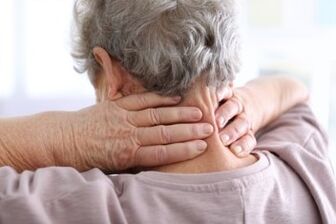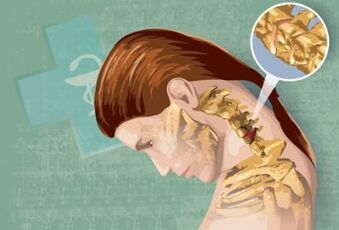In the modern world, the resonance of cervical osteochondosis disease is difficult to overestimate.Osteochondrosis in the cervical region is much more common than in other vertebrates.This disease, to one degree or another, has almost all people over the age of twenty.

Cervical osteochondosis develops mainly due to a sedentary lifestyle, which is particularly facilitated by the historical transition of a person of physical work to the mind, which, although moderate, accompanies the performance of work in sitting position.
Osteochondrosis of the cervical column is a dystrophic degenerative disease of the cervical column, causing damage to intervertebral discs, which is common for osteochondrosis disease.Since this section of the spine is due to its fairly mobile nature, but also vulnerable due to a poorly developed muscle corset, therefore any negative effect on the neck or back, does not affect the cervical region well.Due to the fact that degenerative changes are most often developed in the most mobile vertebrates, nerve endings in C5 ... C7 most often suffer in the cervical region.
Since the symptoms of cervical osteochondosis are very contradictory, they are not always considered solely as the symptoms of this disease, which quite often leads to the treatment of other areas of medicine to obtain aid.Consider them no more details.
Cervical osteochondosis and its symptoms
Due to the fact that the cervical column is quite compact, in comparison with its other departments, it is not even a great tension of the shei muscles or the displacement of the vertebrae of the cervical region, it can cause compression or pinching of the nerve roots, which can also be subjected to ships located in this section.Well, osteophytes are bone growths, in popular treatment called "salt deposit" and trained in the conditions of development of cervical osteochondosis, lead, as a result, only to significant deterioration during the disease.
Clinical manifestations of cervical osteochondrosis disease, that is to say that its symptoms can be divided into reflex symptoms and radicular symptoms of cervical osteochondosis.
Reflex symptoms of cervical osteochondrosis
The reflex symptoms of cervical osteochondosis include the "blows" so called, expressed in the appearance of acute clear pain in the neck, and intensify considerably in all movements.Given this, patients often take a forced and most comfortable position of the head.In addition, the emergence of a typical "crime" during turns or other head movements is also quite possible.

In case of cervical osteochondosis, patients often experience compressive and irradium headache in the eyeballs or the time part of the head.In addition, sometimes, at the same time, the severity of visual perception can fall, as if "everything floats before my eyes".
The vertebral artery syndrome can also develop, when its nervous plexus is irritated, which, very often, due to dizziness in the patient, is wrongly diagnosed with disturbance in the blood circulation of the brain.Such a symptom of cervical osteochondosis can manifest with net head movements and complicate possible nausea and vomiting.
In addition to the above, reflex symptoms of cervical osteochondosis also include cardiological syndrome in which sensations appear similar to angina attack.But such a manifestation of the symptoms of osteochondrosis is generally combined with the complex and other signs of this disease, so this generally does not cause difficulty making the diagnosis correct.
Symptoms of cervical osteochondosis
The radicular symptoms of cervical osteochondosis, as a rule, appear due to the compression of the vertebral nerve ending - the spine.In this case, sensitive disorders affecting the motor functions depend entirely on the injured specific nerve root, namely:
- C1 - a decrease in sensitivity in the nape;
- C2 - The occurrence of pain in the parietal or occipital area of the head;
- C3 - Altered sensitivity and appearance of pain in the neck, where the trauma of the spine occurred with a very possible word function, due to the loss of the sensitivity of language and control over it;
- C4 - The appearance of pain and a decrease in sensitivity in the vertebral area of the owl shoulder, as well as pain in the heart and liver, with the simultaneous decrease in the muscle tone of the neck and possible respiratory disorders of the respiratory function;
- C5 - A decrease in the sensitivity and the occurrence of pain on the surface of the external shoulder;
- C6-Pain, irradium of the cervical spatula, the external surface of the shoulder, the forearm, then from the breakage to the thumb of the hand;
- C7-The same pain as with C6, but the irradium of the scapula on the back of the shoulder, then from the forearm to the fingers 2..4 of the hand, with a decrease in sensitivity in the field of pain;
- C8 - A decrease in sensitivity and pain ranging from the neck on the shoulder, then from the forearm to the little finger of the hand.

Cervical osteochondosis and its treatment
Cervical osteochondosis is a fairly complex and extremely unpleasant disease, for treatment whose systematicity, duration and stage are necessary.Therapeutic treatment of cervical osteochondosis, first of all, aims to complete the symptoms of the pain of cervical osteochondrosis and the elimination of inflammation in the neck affected by the disease.
Patients, in the treatment of cervical osteochondosis, are carried out by conventional pain relievers.Although recently in the treatment of cervical column osteochondrosis, non-steroidal anti-inflammatory drugs effectively relieve pain and reduce the activity of inflammation, in the treatment of osteochondrosis of the spine.
Among other things, chondroprotectors are also used in the treatment of cervical osteochondosis, which slows down the process of destroying the cartilage fabric and, according to so many specialists who also contribute to the regeneration process.In addition, patients are prescribed by the use of B vitamins which improve the metabolic processes of the patient's body.
But the use of external gels or ointments for the treatment of cervical osteochondosis is not effective, but the meaning, because in the process of rubbing in the skin, an additional massage of the cervical column is also carried out.
In addition, combined with traditional drug treatment for cervical osteochondosis, physiotherapy procedures are, and in particular, the use of magnetherapy is particularly effective through special medical devices, for example, a domestic device that has gained well relaxed glory among specialists and patients.It is also applied, in addition to the above, still a therapeutic massage, physiotherapy exercises and manual therapy.But, in particularly serious cases of the disease, surgery may be necessary.
Prevention of cervical osteochondosis disease
The prevention of cervical osteochondosis is not complicated.Recommended:
- lead an active and healthy way of life,
- play sports, or at least morning gymnastics,
- Competent organization of the workplace,
- Compliance with the work and rest regime,
- With prolonged work in a sitting position - during working time, make a hot several times and ensure the correct position of the head and posture during work.
Selecting a comfortable pillow and mattress for sleeping is also important.But for those who already suffer from this disease, daily use for a comfortable sleep of specialized orthopedic products is highly recommended.



















